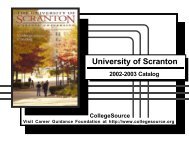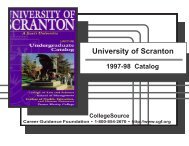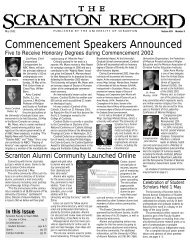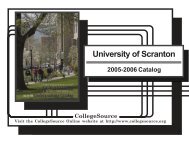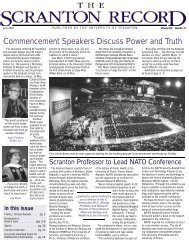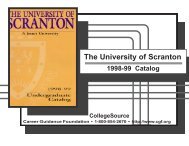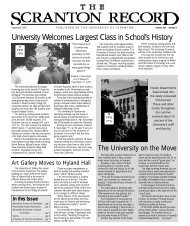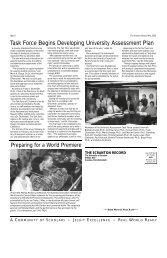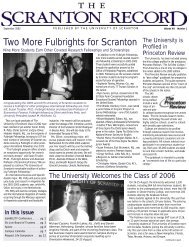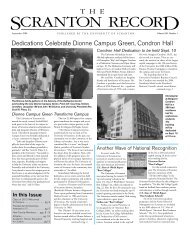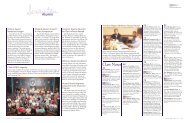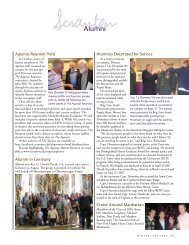2003-2004 - The University of Scranton
2003-2004 - The University of Scranton
2003-2004 - The University of Scranton
You also want an ePaper? Increase the reach of your titles
YUMPU automatically turns print PDFs into web optimized ePapers that Google loves.
176 Arts and Sciences/Physics<br />
PHIL 418 3 cr.<br />
(P) Phenomenology<br />
An introduction to this 20th-century European<br />
movement through selected works <strong>of</strong> Husserl,<br />
Heidegger, Sartre, and Merleau-Ponty. Topics<br />
include the nature <strong>of</strong> the self, lived experience,<br />
history, social reality, sense perception, technology<br />
and science, space and time, the lived body,<br />
and the theory <strong>of</strong> intentionality.<br />
PHIL 420 3 cr.<br />
(P) Philosophy <strong>of</strong> Rhetoric<br />
A systematic investigation <strong>of</strong> the form, meaning<br />
and influence <strong>of</strong> rhetoric. Explores the relationships<br />
between topic and metaphor, logic and<br />
narration, ethos and logos, conscience and persuasion.<br />
Special attention is given to the various<br />
relationships between rhetoric and philosophy.<br />
PHIL 425 3 cr.<br />
Postmodern Philosophy<br />
An examination <strong>of</strong> the transition from modernist<br />
culture and thought to postmodernist culture<br />
and thought. Derrida’s method <strong>of</strong> deconstruction<br />
will serve as the paradigm example <strong>of</strong><br />
postmodernism. Recommended for those interested<br />
especially in literature and fine arts.<br />
PHIL 430 3 cr.<br />
(P) Philosophy <strong>of</strong> the Social and Behavioral<br />
Sciences<br />
<strong>The</strong> goal <strong>of</strong> the course is to encourage students<br />
to think philosophically about issues raised in<br />
social scientific studies, especially regarding the<br />
following: (1) the problem <strong>of</strong> cross-cultural<br />
understanding and interpretation, (2) the difficulties<br />
<strong>of</strong> research design and methodology, and<br />
(3) the relationship between social science, ethics,<br />
and policy making.<br />
PHIL 431 3 cr.<br />
(P) Philosophy <strong>of</strong> Science<br />
An introduction to the history and philosophy<br />
<strong>of</strong> science. Selections from Darwin’s <strong>The</strong> Origins<br />
<strong>of</strong> Species (1859) and <strong>The</strong> Descent <strong>of</strong> Man (1871)<br />
and Popper, Feyerabend, Hanson, Stace, Quine,<br />
Frank, Rescher, Hempel, and Baier.<br />
PHIL 434 3 cr.<br />
(P) Issues in Philosophy and <strong>The</strong>ology<br />
This course will investigate certain modern and<br />
contemporary problems in the relationship<br />
between philosophy and theology. In particular,<br />
it will examine the ways in which philosophical<br />
discussions (both specific arguments and general<br />
positions) influence theological discussions, as<br />
evidence <strong>of</strong> the suggestion that philosophy “gives<br />
voice” to theology.<br />
PHYSICS<br />
Faculty<br />
Robert A. Spalletta, Ph.D., Chair<br />
W. Andrew Berger, Ph.D.<br />
Joseph W. Connolly, Ph.D.<br />
Paul F. Fahey, Ph.D.<br />
John R. Kalafut, M.S.<br />
Argyrios C. Varonides, Ph.D.<br />
Christine A. Zakzewski, Ph.D.<br />
Overview<br />
<strong>The</strong> Department <strong>of</strong> Physics and Electrical<br />
Engineering <strong>of</strong>fers majors in Physics and Biophysics,<br />
as well as the Electrical Engineering,<br />
Computer Engineering and Electronics-Business<br />
majors described earlier. <strong>The</strong> objectives<br />
<strong>of</strong> the department are to provide skills, understanding,<br />
and the methodology required to<br />
initiate active participation in the development<br />
<strong>of</strong> new knowledge about the material<br />
universe. <strong>The</strong> approach <strong>of</strong> the physicist, based<br />
as it is on the analysis <strong>of</strong> mathematical models<br />
dealing with matter and energy and their<br />
interactions, supplies a unique and important<br />
insight to the solution <strong>of</strong> problems in many<br />
disciplines.<br />
A 1988 study by the Office <strong>of</strong> Institutional<br />
Research at Franklin and Marshall College<br />
shows that over 66 years, <strong>The</strong> <strong>University</strong> <strong>of</strong><br />
<strong>Scranton</strong> ranked 33rd out <strong>of</strong> 977 four-year,<br />
private, primarily undergraduate institutions<br />
as the baccalaureate origin <strong>of</strong> physics doctorates.<br />
In addition, the Biophysics concentration<br />
in recent years has regularly produced<br />
students admitted to medical school.<br />
Minor in Physics<br />
21 credits, including PHYS 140, 141, 270<br />
(all with labs), 352, ENGR 252, and at least<br />
one <strong>of</strong> PHYS 473, 372 and/or 371.<br />
Major in Biophysics<br />
<strong>The</strong> Biophysics major is designed to prepare<br />
a student to apply the physical and<br />
mathematical sciences to problems arising in<br />
the life sciences and medicine. By choosing<br />
proper electives, the student can prepare to<br />
enter graduate study <strong>of</strong> biophysics, biology,<br />
biochemistry, medicine or dentistry.



